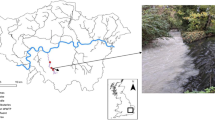Abstract
The uptake of dissolved organic carbon by three stream bed components; surface stones, underlying gravel and organic floc was measured in three rivers in North Wales, U.K. Overall, surface stones and underlying gravel appeared to be the major sites of uptake but the relative importance of these two components varied both temporally and spatially. Organic floc was found to be relatively unimportant as a site of dissolved organic carbon uptake.
Similar content being viewed by others
References
Bott, T. L., Preslan, J., Finlay, H. & Brunker, R., 1977. The use of flowing-water microcosms and ecosystem streams to study microbial degradation of leaf litter and nitroltriacetic acid (NTA). Dev. Ind. Microbiol. 18: 171–184.
Collins, K. J. & Williams, P. J. le B., 1977. An automated photochemical method for the determination of dissolved organic carbon in sea and estuarine waters. Mar. Chem. 5: 123–141.
Cummins, K. W., Klug, J. J., Wetzel, R. G., Petersen, R. C., Subercropp, K. F., Manny, B. A., Wuychechk, J. C. & Howard, F. O., 1972. Organic enrichment with leaf leachate in experimental lotic ecosystems. Bioscience 22: 719–722.
Dahm, C. N., 1981. Pathways and mechanisms for removal of dissolved organic carbon from leaf leachate in streams. Can. J. Fish. aquat. Sci. 38: 68–76.
Erhardt, M., 1969. A new method for the automatic measurement of dissolved organic carbon in sea water. Deep Sea Res. 16: 393–397.
Lock, M. A., 1981. River epilithon — a light and organic energy transducer. In: Lock, M. A., & Williams, D. D., (eds). Perspectives in Running Water Ecology. Plenum, N.Y., 430 pp.
Lock, M. A. & Hynes, H. B. N., 1975. The disappearance of four leaf leachates in a hard and soft water stream in South Western Ontario, Canada. Int. Revue ges. Hydrobiol. 60: 847–855.
Lock, M. A. & Hynes, H. B. N., 1976. The fate of ‘dissolved’ organic carbon derived from autumn-shed maple leaves (Acer saccharum) in a temperate hardwater stream. Limnol. Oceanogr. 21: 436–443.
Lock, M. A., Wallace, R. R., Costerton, J. W., Ventullo, R. M. & Charlton, S. E., in press. River epilithon — toward a structural-functional model. Oikos.
Lush, D. L. & Hynes, H. B. N., 1978. The uptake of dissolved organic matter by a small spring stream. Hydrobiologia 60: 271–275.
McDowell, W. H., 1982. Mechanisms controlling the organic chemistry of Bear Brook, New Hampshire. Unpubl. Ph.D. thesis, Cornell University. 152 pp.
McDowell, W. H. & Fisher, S. G., 1976. Autumnal processing of dissolved organic matter in a small woodland stream ecosystem. Ecology 57: 561–569.
Newbold, J. D., Mulholland, P. J., Elwood, J. W. & O'Neill, R. V., 1982. Organic carbon spiralling in stream ecosystems. Oikos 38: 266–272.
Strahler, A. N., 1957. Quantitative analysis of watershed geomorphology. Trans. am. Geophys. Union 38: 913–920.
Wallis, P. M., 1981. The uptake of dissolved organic matter in groundwater by stream sediments — A case study. In: Lock, M. A. & Williams, D. D. (eds.). Perspectives in Running Water Ecology. Plenum, N.Y., 430 pp.
Williams, D. D., in press. The hyporheic zone as a habitat for aquatic insects and associated arthropods. In: Resh, V. H. & Rosenberg, D. R. (eds). The ecology of Aquatic Insects. Praeger Scientific (CBS. Inc.) N.Y.
Wetzel, R. G. & Manny, B. A., 1972. Decomposition of dissolved organic carbon and nitrogen compounds from leaves in an experimental hard-water stream. Limnol. Oceanogr. 17: 927–931.
Author information
Authors and Affiliations
Rights and permissions
About this article
Cite this article
Mickleburgh, S., Lock, M.A. & Ford, T.E. Spatial uptake of dissolved organic carbon in river beds. Hydrobiologia 108, 115–119 (1984). https://doi.org/10.1007/BF00014870
Received:
Revised:
Accepted:
Issue Date:
DOI: https://doi.org/10.1007/BF00014870




